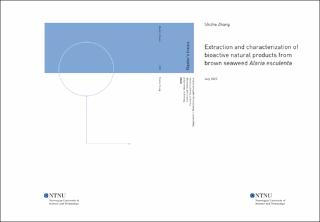| dc.description.abstract | Natural products are chemical compounds found in natural sources including terrestrial and marine organisms. In addition to their nutritional values, natural products can also exhibit health benefits such as antipathogenic, antioxidant and antidiabetic, which are known as bioactivities. Compared to plants, seaweeds have similar chemical composition, yet are a more sustainable source for food and bioactive natural products, and therefore have been drawing an increasing attention in recent years. For instance, countries in Europe have expanded the seaweed production and harvest, with Norway contributing more than half of the volume. The two primary seaweed species harvested in Norway are the brown seaweeds Alaria esculenta and Saccharina latissima. In this study, the focus has been on the extraction, fractionation and characterization of bioactive natural products from these two species. During fractionation bioassays were employed to measure the bioactivities: the total phlorotannin contents (TPhCs) of the seaweed extracts were quantified by 2,4-dimethoxybenzaldehyde (DMBA) assay, and enzyme inhibition assays including collagenase and α-amylase were used. The separation techniques included liquid-liquid partitioning, macroporous adsorptive resins XAD-16, Sephadex® LH-20 column chromatography, and preparative reversed-phase HPLC-MS. High resolution QToF LC-MS was used to pinpoint m/z ratios that may represent the bioactive compounds in the active fractions. New fractions were generated based on the identified m/z ratios and were tested for α-amylase inhibition.
Out of the four crude extracts of the enzyme-treated A. esculenta and S. latissima by absolute methanol and 70% (v/v) ethanol, the methanol extract of A. esculenta showed the highest TPhCs of 0.63 mg phloroglucinol equivalents/g dry residue, and α-amylase and collagenase inhibition of 46% and 15%, respectively. A large-scale methanol extract of A. esculenta was thus prepared and fractionated following the bioactivity of α-amylase inhibition. Fractions were characterized by 1H 1D and 2D NMR spectroscopic techniques. The carotenoid metabolites loliolide and its isomer, (+)-epiloliolide, were for the first time identified from the species A. esculenta. The other fractions were complex mixtures that contained sugar, glycerol and lipid moieties. NMR spectroscopy was used to assign partial structures of these moieties that were identified as glycerolipids. Additional signals were also observed and were hypothesized to represent degraded phlorotannins or phenyl-terminated lipid, hydroxylated lipids and conjugated lipids. The results suggest that the natural products in A. esculenta are highly likely to inhibit α-amylase. | |
